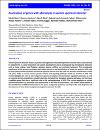Association of genes with phenotype in autism spectrum disorder.
| Author | Nisar, Sabah |
| Author | Hashem, Sheema |
| Author | Bhat, Ajaz A |
| Author | Syed, Najeeb |
| Author | Yadav, Santosh |
| Author | Azeem, Muhammad Waqar |
| Author | Uddin, Shahab |
| Author | Bagga, Puneet |
| Author | Reddy, Ravinder |
| Author | Haris, Mohammad |
| Available date | 2020-09-14T07:01:51Z |
| Publication Date | 2019-11-19 |
| Publication Name | Aging |
| Identifier | http://dx.doi.org/10.18632/aging.102473 |
| Citation | Nisar S, Hashem S, Bhat AA, et al. Association of genes with phenotype in autism spectrum disorder. Aging (Albany NY). 2019;11(22):10742-10770. doi:10.18632/aging.102473 |
| Abstract | Autism spectrum disorder (ASD) is a genetic heterogeneous neurodevelopmental disorder that is characterized by impairments in social interaction and speech development and is accompanied by stereotypical behaviors such as body rocking, hand flapping, spinning objects, sniffing and restricted behaviors. The considerable significance of the genetics associated with autism has led to the identification of many risk genes for ASD used for the probing of ASD specificity and shared cognitive features over the past few decades. Identification of ASD risk genes helps to unravel various genetic variants and signaling pathways which are involved in ASD. This review highlights the role of ASD risk genes in gene transcription and translation regulation processes, as well as neuronal activity modulation, synaptic plasticity, disrupted key biological signaling pathways, and the novel candidate genes that play a significant role in the pathophysiology of ASD. The current emphasis on autism spectrum disorders has generated new opportunities in the field of neuroscience, and further advancements in the identification of different biomarkers, risk genes, and genetic pathways can help in the early diagnosis and development of new clinical and pharmacological treatments for ASD. |
| Language | en |
| Publisher | Impact Journals |
| Subject | gene transcription genetic variants neuronal activity signaling pathways synaptic plasticity |
| Type | Article Review |
| Pagination | 10742-10770 |
| Issue Number | 22 |
| Volume Number | 11 |
| ESSN | 1945-4589 |
Files in this item
This item appears in the following Collection(s)
-
Laboratory Animal Research Center (Research) [152 items ]


